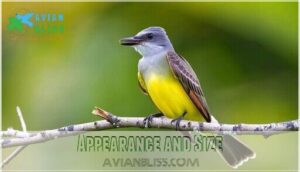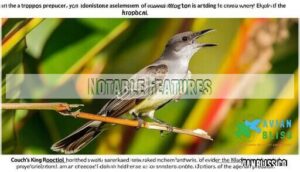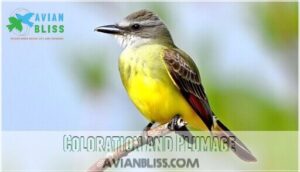This site is supported by our readers. We may earn a commission, at no cost to you, if you purchase through links.

This 8-9 inch flycatcher dominates the brushy landscapes of South Texas and eastern Mexico, where it fearlessly attacks much larger birds that invade its territory.
Unlike many flycatchers that lurk quietly in dense foliage, Couch’s kingbird perches prominently on fence posts and power lines, launching aerial sallies to snatch flying insects with remarkable precision.
Its distinctive sharp "kip" calls and aggressive territorial behavior make identification straightforward once you know the key field marks.
Table Of Contents
- Key Takeaways
- Physical Characteristics of Couch’s Kingbird
- Habitat and Distribution of Couch’s Kingbird
- Behavioral Traits of Couch’s Kingbird
- Vocalizations and Communication of Couch’s Kingbird
- Conservation Status and Future Challenges
- Frequently Asked Questions (FAQs)
- What is the range of the Couch’s kingbird?
- What are the threats to the couch’s kingbird population?
- Why are they called Kingbirds?
- What is the difference between Couchs and Western Kingbirds?
- How do you identify a couch’s kingbird?
- How big is Couch’s kingbird?
- What is the difference between ash throated flycatchers and Kingbirds?
- How did Couchs Kingbird get its name?
- What do Couchs Kingbirds eat besides insects?
- How long do Couchs Kingbirds typically live?
- Conclusion
Key Takeaways
- You’ll identify Couch’s kingbird by its distinctive three-toned appearance – olive-brown back, bright yellow belly, and gray head with dark eye mask, plus sharp "kip" calls that distinguish it from similar species.
- You’ll find these aggressive territorial birds in South Texas brushlands and eastern Mexico, where they fearlessly attack much larger intruders and perch prominently on fence posts rather than hiding in dense foliage.
- You’ll observe their specialized hunting behavior through aerial sallies – they launch from exposed perches to snatch flying insects with remarkable precision, making them efficient natural pest controllers.
- You’ll encounter a species with stable conservation status despite facing habitat loss from urban development, with populations showing resilience and northward expansion over recent decades.
Physical Characteristics of Couch’s Kingbird
You’ll immediately recognize Couch’s Kingbird by its medium-sized flycatcher build, measuring approximately 8-9 inches with a wingspan reaching 15 inches.
This robust bird displays olive-brown upperparts contrasting with pale yellow underparts, while its distinctive dark mask through the eyes and slightly notched tail help distinguish it from similar species.
Appearance and Size
Measuring 8-9 inches in body length with a wingspan reaching approximately 15 inches, Couch’s Kingbird (Tyrannus couchii) presents distinctive physical characteristics for accurate bird species identification.
The gray head color contrasts sharply with its bright yellow belly, while the whitish throat creates a striking three-toned plumage pattern. Its robust beak shape, designed for capturing flying insects, complements feather patterns that distinguish it from similar flycatcher species.
Understanding the unique bird physical features is essential for identifying and studying various bird species.
Here are five key identification markers:
- Proportional build – stocky frame with broad shoulders
- Distinctive coloration – gray-yellow-white tricolor arrangement
- Prominent beak – thick, slightly hooked for insect capture
- Wing markings – subtle dark flight feathers with pale edging
- Tail structure – squared-off appearance with faint notching
Notable Features
When observing Couch’s kingbirds, you’ll notice several distinctive features that set this tyrant flycatcher apart from similar species.
These kingbird characteristics reflect remarkable adaptive traits evolved for their ecological role as aerial predators.
Key notable features include:
- Proportionally large head with a slightly flattened crown that houses their keen eyesight for spotting prey
- Robust, slightly hooked bill perfectly designed for grasping insects during aerial acrobatics
- Notched tail feathers that function as rudders during quick directional changes while hunting
- Strong, sturdy legs adapted for secure perching on exposed branches in windy conditions.
These behavioral quirks and physical adaptations allow couchs kingbird to excel in their demanding lifestyle as insect hunters, distinguishing them through both form and function.
Coloration and Plumage
Couch’s Kingbird displays striking Plumage Texture with its bright yellow belly contrasting against olive-gray upperparts.
The distinctive Feather Patterns include darker ear patches and white throat markings that enhance bird species distinctiveness.
Wing Bars appear subtle yet noticeable during flight displays.
The Tail Feathers exhibit dark brown coloration with slight notching.
The Beak Color appears dark gray-black, perfectly suited for capturing insects in lightly wooded areas.
During molting periods, plumage variations become more pronounced, temporarily altering the bird’s characteristic appearance.
Habitat and Distribution of Couch’s Kingbird
You’ll find Couch’s Kingbird inhabiting the brushy landscapes of southern Texas and eastern Mexico, where it thrives in riparian woodlands, thorn forests, and increasingly in suburban areas with mature trees.
From brushy Texas landscapes to Mexican woodlands, Couch’s Kingbird calls these thorny havens home
This species demonstrates remarkable adaptability, expanding its range northward over the past century while maintaining strong site fidelity to areas that provide the dense woody vegetation it prefers over open country, showing a clear preference for certain habitats.
Preferred Environments
Understanding Couch’s Kingbird habitat preferences reveals their specialty niche among flycatchers.
These birds thrive in semi-open environments that balance cover with foraging opportunities:
- Riparian edges along streams and water sources provide ideal hunting perches
- Open woodlands with scattered trees offer nesting sites in sugar hackberry and cedar elm
- Savannas and farmland create perfect intermediate zones between forest and field
- Suburban areas with mature trees support expanding populations throughout South Texas Brush Country
Couch’s kingbird habitat preferences center on brushland environments that provide both concealment and open flight paths for their signature sallying behavior.
The birds’ distribution is influenced by breeding bird surveys that track their population trends.
Geographical Range
Across its geographic distribution, Couch’s Kingbird inhabits South Texas and extends southward through eastern Mexico into northern Central America.
These breeding areas showcase distinct habitat preferences for riparian woodlands and thorn forests.
Range expansion northward over recent decades reflects successful colonization of maturing residential landscapes.
Migration patterns vary regionally, with permanent residents in southern territories and irregular movements in northern populations.
Current bird distribution maps document established populations from the Rio Grande valley through the Yucatan Peninsula, demonstrating remarkable adaptability within preferred ecosystems.
Seasonal Movements
Couch’s Kingbird migration patterns reveal remarkable adaptability. These birds arrive in Texas from early March to early April, establishing breeding seasons that extend through late August.
Their flight routes follow the eastern coastal plain, with seasonal shifts creating irregular migration patterns influenced by winter temperatures.
Wintering habits vary substantially – while permanent residents occupy central ranges, northern populations migrate south from late August through mid-October, demonstrating flexible couchs kingbird migration strategies that maximize survival across changing environmental conditions.
Understanding bird migration basics is vital for grasping the nuances of Couch’s Kingbird migration patterns.
Behavioral Traits of Couch’s Kingbird
You’ll observe Couch’s Kingbird exhibiting remarkable hunting prowess as it performs swift aerial sallies from prominent perches to capture flying insects mid-flight.
This species demonstrates complex social behaviors including aggressive territorial defense, elaborate courtship displays, and sophisticated communication patterns that distinguish it from closely related kingbird species.
Foraging Behavior
Throughout their active hunting periods, Couch’s Kingbirds demonstrate remarkable aerial acrobatics and sophisticated foraging strategies.
Masters of aerial combat, these kingbirds turn insect hunting into an art form through precision and power
These skilled flycatchers employ three primary hunting techniques:
- Perch-and-wait strategy – positioning themselves on exposed branches to scan for flying insects
- Mid-air insect capture – launching explosive sallying flights to snag beetles, bees, and wasps
- Hovering prey selection – maintaining stationary flight while gleaning insects from foliage
Their feeding habits showcase exceptional precision in aerial maneuvers, making them efficient pest controllers.
Kingbirds have a particular preference for insects.
These hunting techniques vary seasonally, with fruit consumption supplementing their insect-heavy bird diet during non-breeding periods.
Social Interactions
Observe these territorial defenders establishing clear boundaries through aggressive confrontations and aerial pursuits.
Dominance hierarchy structures emerge within mixed flocks, with alpha individuals claiming prime perches while subordinates maintain respectful distances.
Their interspecies relations reveal fascinating dynamics—they’ll aggressively chase larger Bronzed Cowbirds yet tolerate smaller songbirds nearby.
| Social Behavior | Description |
|---|---|
| Territorial Defense | Aggressive aerial chases against intruders |
| Flock Dynamics | Clear dominance hierarchy with alpha leaders |
| Interspecies Relations | Selective aggression based on threat level |
| Communication Signals | Posturing and vocalizations establish status |
| Seasonal Changes | Increased aggression during breeding periods |
Reproductive Behavior
During couchs kingbird breeding season, males perform intricate mating rituals including wing-quivering displays and crown feather raising to establish territories.
Pairs engage in conspicuous calling and wing-fluttering greetings that strengthen bonds. Females construct cup-shaped nests averaging 3 inches diameter in preferred trees, maintaining typical clutch size of 3-4 cream-colored eggs with brown markings.
Both parents provide dedicated parental care through feeding and nest defense. Their vocalizations are key to territorial defense.
- Witness breathtaking aerial courtship displays as males showcase their vibrant plumage during territorial establishment
- Marvel at their fierce devotion when adults aggressively chase away cowbirds and grackles threatening their precious broods
- Experience nature’s teamwork as both parents tirelessly feed and shade helpless nestlings for weeks after hatching
- Feel the intensity of their protective instincts when kingbird breeding pairs coordinate sophisticated nest defense strategies
Vocalizations and Communication of Couch’s Kingbird
You’ll instantly recognize Couch’s Kingbird by its distinctive vocalizations, which serve as the primary identifying feature separating it from the nearly identical Tropical Kingbird.
These loud, harsh calls function as territorial markers and communication tools that reveal the species’ complex social behaviors and breeding strategies.
Distinctive Calls
Couch’s Kingbird vocalizations demonstrate remarkable call variation across their range, with distinctive calls serving as their primary identification feature.
Regional dialects exist among populations, though vocal mimicry remains minimal compared to other flycatcher species.
Their acoustic ecology reflects territorial needs through persistent bird vocalizations.
| Call Type | Function | Acoustic Pattern |
|---|---|---|
| Sharp "pik" | Territory marking | Single, nasal note |
| "Pik-pik-pikweer" | Alarm/threat response | Intensifying sequence |
| Dawn chorus | Mate attraction | Repeated territorial calls |
These bird calls enable species identification when visual differences from Tropical Kingbirds prove challenging in overlapping ranges.
Communication Methods
Within their expansive vocal repertoire, Couch’s kingbirds employ sophisticated communication methods that extend beyond basic calls.
These birds utilize distinctive calls ranging from sharp "pik" notes to complex sequences for territory defense and mate attraction.
Visual signals complement vocalizations through wing positioning and tail movements during courtship displays.
Alarm calls serve as community warnings, while specialized notes facilitate inter-species communication with neighboring species.
This multi-modal approach demonstrates the advanced bird communication systems that distinguish Couch’s kingbird from other flycatcher species.
Significance of Vocalizations
Acoustic mastery defines Couch’s Kingbird communication systems, enabling precise species recognition through distinctive calls that prevent hybridization with closely related tropical flycatchers.
These bird vocalizations demonstrate remarkable acoustic adaptation, allowing effective vocal differentiation across varying environmental conditions.
Vocalization identification reveals three primary song functions:
- Territorial proclamation – Aggressive calls establish dominance hierarchies and defend breeding territories
- Mate selection signals – Complex vocal patterns attract suitable partners during courtship rituals
- Parent-offspring coordination – Distinctive calls facilitate feeding schedules and predator warnings
Dialect variations occur across geographical ranges, with couchs kingbird populations developing region-specific vocal signatures that enhance local communication effectiveness while maintaining species-wide recognition patterns.
These signatures are influenced by learned song patterns, passed down through generations.
Conservation Status and Future Challenges
You’ll find Couch’s Kingbird occupies a relatively stable position among North American birds, though specific population data remains limited due to its restricted range.
Current conservation challenges center on habitat loss from urban development and agricultural expansion throughout its South Texas stronghold and Mexican coastal plain distribution, which poses a significant threat to the species’ well-being, particularly in terms of conservation efforts.
Current Conservation Status
Looking beyond their distinctive calls, Couch’s Kingbird enjoys favorable conservation status.
The IUCN Red List classifies this species as Least Concern, reflecting stable population trends across its range.
With approximately 1.1 million breeding individuals globally, the species demonstrates resilience against moderate habitat loss.
The bird’s classification places it in the Tyrannidae family, the largest avian family in the Americas.
Conservation efforts focus on monitoring regional population trends, particularly in urbanizing Texas landscapes.
North American Breeding Bird Survey data reveals strong increases from 1966-2015, supporting optimistic future outlook despite potential climate impact concerns in edge populations.
Threats and Concerns
Several significant threats challenge Couch’s Kingbird populations across their range. Habitat Loss represents the primary concern as urbanization and deforestation eliminate essential thorn forests and riparian woodlands throughout Mexico and Central America.
Climate Change compounds these pressures by altering precipitation patterns and temperature ranges, potentially forcing range shifts northward while reducing suitable breeding habitat.
Key threats include:
- Human Disturbance from agricultural expansion and infrastructure development displacing nesting birds from traditional territories
- Pesticide Use reducing insect prey availability, particularly during critical breeding seasons when protein demands peak
- Invasive Species competition for nesting sites and food resources in fragmented landscapes
Brood parasitism by Bronzed Cowbirds further reduces reproductive success, while nest predation by Great-tailed Grackles threatens fledgling survival rates across occupied ranges.
Conservation Efforts and Recommendations
Conservation efforts for Couch’s Kingbird focus on habitat preservation through riparian woodland protection and invasive species control.
Bird conservation efforts include monitoring programs that track nesting success and implement cowbird mitigation strategies.
Public awareness campaigns engage citizens in reporting sightings, supporting range expansion documentation, and these bird habitat conservation initiatives help maintain stable populations across the species’ distribution.
You can find bird conservation products to help support these conservation efforts and maintain a healthy environment for the species.
Frequently Asked Questions (FAQs)
What is the range of the Couch’s kingbird?
You’ll find this charismatic flycatcher’s domain stretching from southern Texas down Mexico’s eastern coastal plain.
Through the Yucatán Peninsula into northern Guatemala and Belize, with permanent residence in warmer southern territories, is where this bird can also be found, making its home in these areas.
What are the threats to the couch’s kingbird population?
You’ll face significant habitat loss from expanding agriculture and urban development across Texas rangelands.
Climate change increasingly threatens nesting sites, while pesticide use reduces insect prey availability for successful breeding seasons.
Why are they called Kingbirds?
Like feathered monarchs ruling their aerial kingdom, kingbirds earned their regal name through their aggressive territorial behavior.
You’ll observe them fearlessly attacking much larger birds, including hawks and crows, that dare enter their domain during breeding season.
What is the difference between Couchs and Western Kingbirds?
You’ll notice Western Kingbirds prefer open grasslands and prairies.
While Couch’s Kingbirds favor dense brush and thorny woodlands.
Their ranges overlap in Texas, but vocalizations remain your most reliable identification tool.
How do you identify a couch’s kingbird?
You’ll recognize Couch’s Kingbird by its grayish head, yellow belly, and distinctive calls.
Listen for harsh "kip" notes versus Tropical Kingbird’s rolling trills.
Look for the notched tail and aggressive territorial behavior in South Texas brushlands.
How big is Couch’s kingbird?
You’ll find Couch’s Kingbird measures about 8-9 inches long with a wingspan reaching 15-16 inches.
These medium-sized flycatchers weigh roughly 3-6 ounces, making them comparable to other kingbird species in overall dimensions, with a size that is also notable for being a medium-sized flycatcher.
What is the difference between ash throated flycatchers and Kingbirds?
Ash-throated Flycatchers are smaller birds with pale yellow bellies, rufous tails, and subtle crests, while kingbirds are larger with prominent white tail bands, darker plumage, and more aggressive territorial behavior.
How did Couchs Kingbird get its name?
Straight from the horse’s mouth, you’ll discover this kingbird honors Lieutenant Darius N. Couch, who first spotted the species near San Diego, Nuevo Leon, Mexico in
Leading to its formal scientific description by Baird in
What do Couchs Kingbirds eat besides insects?
Beyond insects, you’ll find Couch’s Kingbirds eating fruits and berries, especially during non-breeding seasons when they supplement their diet with these plant materials for additional nutrition.
How long do Couchs Kingbirds typically live?
Consider a bird banded near San Antonio in
While specific lifespan data for Couch’s Kingbirds isn’t well-documented, other Tyrannus species have been reported living over 11 years in the wild.
This suggests you’ll likely observe these resilient flycatchers for a similar decade-plus timespan in their Texas habitats.
Conclusion
Through the lens of avian observation, Couch’s kingbird emerges as nature’s feathered sentinel in the borderlands.
You’ll discover this species represents resilience in changing landscapes, adapting to human-modified environments while maintaining its fierce territorial instincts.
Understanding Couch’s kingbird behavior patterns enhances your ability to identify and appreciate these remarkable flycatchers during field observations.
Their distinctive vocalizations and bold hunting strategies demonstrate evolutionary adaptations to semi-arid ecosystems, making them essential indicators of regional biodiversity health.
- http://ebird.org/ebird/map/coukin?neg=true&env.minX=128.08720912839692&env.minY=-15.703023859118971&env.maxX=-3.2213846216031925&env.maxY=74.42707121783371&zh=true&gp=false&ev=Z&mr=1-12&bmo=1&emo=12&yr=all&byr=1900&eyr=2019
- http://www.iucnredlist.org/details/22700488/0
- http://www.birdlife.org/datazone/speciesfactsheet.php?id=4409
- https://www.audubon.org/field-guide/bird/couchs-kingbird
- https://www.xeno-canto.org/species/Tyrannus-couchii












